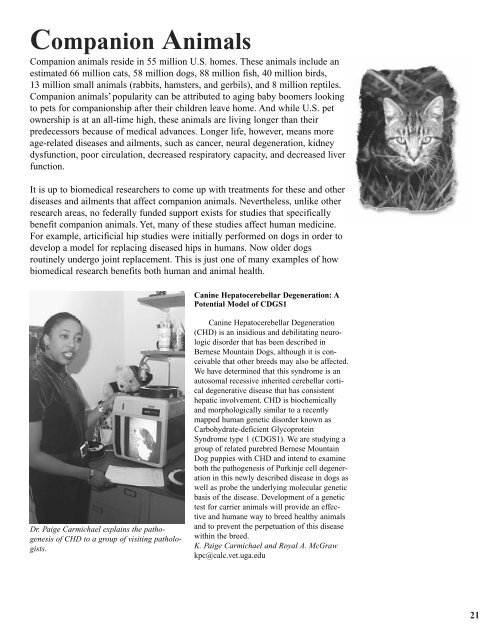in Oregon. The objective <strong>of</strong> this study was todetermine if white-tailed deer in <strong>Georgia</strong> carryE. coli O157:H7.During summer 1997, more than 300 freshdeer fecal samples were collected from theground at five <strong>Georgia</strong> wildlife areas. Duringautumn 1997, nearly 400 fecal samples werecollected directly from hunter-killed deer at thesame locations plus an additional area. Fecalsamples were cultured for E. coli O157:H7.All samples collected from the groundwere culture-negative. Three samples (0.8%)collected directly from deer were positive forE. coli O157:H7. The three isolates were from77 deer sampled (3.8%) during November atone area. Two <strong>of</strong> the three isolates had identicalDNA fingerprints. All three isolates producedShiga-like toxins 1 and 2. Samples <strong>of</strong>frozen processed meat from the three positivedeer were culture-negative for E. coliO157:H7.Results <strong>of</strong> this study suggest that the overallprevalence <strong>of</strong> E. coli O157:H7 is low infree-ranging deer; however, there may be focalareas where deer harbor the bacteria. Cattlewere present in the vicinity where the positivedeer were found, but they also were present atother sites where deer were culture-negative.Additionally, the results suggest that contamination<strong>of</strong> meat did not occur during field dressingand processing <strong>of</strong> the three deer carryingE. coli O157:H7.John R. Fischer, Tong Zhao, andMichael P. Doyle *jfischer@calc.vet.uga.edu* Food Science and TechnologyExperimental Infection <strong>of</strong> Deer Mice withVesicular Stomatitis VirusVesicular stomatitis (VS) is a viral disease<strong>of</strong> cattle, horses, and swine, that causes substantialeconomic losses to livestock producers.The epidemiology <strong>of</strong> this disease is currentlyundefined, but it is suspected that the virus ismaintained in a vertebrate/insect vector cycleinvolving wildlife. To determine if native wildrodents may be involved in this cycle, a pilotstudy involving experimental infection <strong>of</strong> 100deer mice (Peromyscus maniculatus) withvesicular stomatitis virus (VSV), New Jersey(NJ) serotype, was performed. The virus usedin this study was originally isolated from sandflies collected on Ossabaw Island, <strong>Georgia</strong>.Viremia was detected in infected mice duringpostinoculation days one through three. Viruswas isolated from various tissues from 96 <strong>of</strong>100 mice from postinoculation days onethrough seven, and virus isolation results wereconfirmed by polymerase chain reaction(PCR), immunohistochemical detection <strong>of</strong>virus in tissues, and in situ hybridization <strong>of</strong>viral RNA in tissues. Following this pilotstudy, a series <strong>of</strong> experiments were conductedto compare the outcome <strong>of</strong> infection in deermice with two different strains <strong>of</strong> VSV-NJ. TheOssabaw Island strain was compared with aVSV-NJ isolate from a recent VS outbreak(1995) in Colorado, with emphasis on development<strong>of</strong> viremia, clinical outcome, and distribution<strong>of</strong> virus in tissues. The Colorado strain <strong>of</strong>VSV-NJ produced a significantly higher level<strong>of</strong> viremia and caused central nervous systemdisease sooner than the Ossabaw Island strain<strong>of</strong> VSV-NJ. Further experiments using thisdeer mouse model are planned to investigatethe effects <strong>of</strong> route <strong>of</strong> inoculation and dose <strong>of</strong>virus on development and extent <strong>of</strong> viremia,the effects <strong>of</strong> pregnancy on infection, andeventually, the potential for viremic deer miceto infect appropriate insect vectors. Resultsfrom this study provide the first evidence that avertebrate host can become viremic and thusprovide a source <strong>of</strong> VSV-NJ to biting arthropodsand eventually livestock. Results alsoindicate that the deer mouse can provide avaluable research tool to further study vectorcompetence <strong>of</strong> suspected biting insect species.David E. Stallknecht, Elizabeth W. Howerth,and Todd E. Cornishdstall@calc.vet.uga.edu20
Companion AnimalsCompanion animals reside in 55 million U.S. homes. These animals include anestimated 66 million cats, 58 million dogs, 88 million fish, 40 million birds,13 million small animals (rabbits, hamsters, and gerbils), and 8 million reptiles.Companion animals’ popularity can be attributed to aging baby boomers lookingto pets for companionship after their children leave home. And while U.S. petownership is at an all-time high, these animals are living longer than theirpredecessors because <strong>of</strong> medical advances. Longer life, however, means moreage-related diseases and ailments, such as cancer, neural degeneration, kidneydysfunction, poor circulation, decreased respiratory capacity, and decreased liverfunction.It is up to biomedical researchers to come up with treatments for these and otherdiseases and ailments that affect companion animals. Nevertheless, unlike otherresearch areas, no federally funded support exists for studies that specificallybenefit companion animals. Yet, many <strong>of</strong> these studies affect human medicine.For example, articificial hip studies were initially performed on dogs in order todevelop a model for replacing diseased hips in humans. Now older dogsroutinely undergo joint replacement. This is just one <strong>of</strong> many examples <strong>of</strong> howbiomedical research benefits both human and animal health.Canine Hepatocerebellar Degeneration: APotential Model <strong>of</strong> CDGS1Dr. Paige Carmichael explains the pathogenesis<strong>of</strong> CHD to a group <strong>of</strong> visiting pathologists.Canine Hepatocerebellar Degeneration(CHD) is an insidious and debilitating neurologicdisorder that has been described inBernese Mountain Dogs, although it is conceivablethat other breeds may also be affected.We have determined that this syndrome is anautosomal recessive inherited cerebellar corticaldegenerative disease that has consistenthepatic involvement. CHD is biochemicallyand morphologically similar to a recentlymapped human genetic disorder known asCarbohydrate-deficient GlycoproteinSyndrome type 1 (CDGS1). We are studying agroup <strong>of</strong> related purebred Bernese MountainDog puppies with CHD and intend to examineboth the pathogenesis <strong>of</strong> Purkinje cell degenerationin this newly described disease in dogs aswell as probe the underlying molecular geneticbasis <strong>of</strong> the disease. Development <strong>of</strong> a genetictest for carrier animals will provide an effectiveand humane way to breed healthy animalsand to prevent the perpetuation <strong>of</strong> this diseasewithin the breed.K. Paige Carmichael and Royal A. McGrawkpc@calc.vet.uga.edu21
- Page 3 and 4: VM E S ‘98Veterinary Medical Expe
- Page 7 and 8: DNA VaccinesEver since Dr. Edward J
- Page 9 and 10: Differential Diagnosis of Infectiou
- Page 11 and 12: Hemolysin is one type of virulence
- Page 13 and 14: ism without the epv gene. The resul
- Page 15 and 16: Cattle and Other RuminantsCattle, s
- Page 17 and 18: The Use of in situ Hybridization to
- Page 19 and 20: Endotoxin Antagonists: Characterizi
- Page 21: WildlifeGeorgia’s wildlife habita
- Page 25 and 26: esearch paid for by VMES funds wher
- Page 27 and 28: Research Contracts and GrantsAllen,
- Page 29 and 30: Administrators and AdvisorsThe Univ
- Page 31 and 32: Hullinger, Gordon A., DVM, PhD, Ass
- Page 33 and 34: Selected PublicationsAllen, S.W., C
- Page 35 and 36: Hay, W.P., Baskett, A., Abdy, M.J.:
- Page 37 and 38: Quist, C.F., Howerth, E.W., Bounous

















